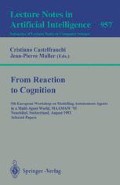Abstract
A basic N x M instance (game) of the Pursuit Problem is one in which N pursuing agents try to capture as many as possible of M prey agents by surrounding them, on a rectilinear grid. The 4 × 1 game has been considered as a testbed for comparing the effectiveness of different multiagent distributed architectures, and the 6 × 2 game has received a little attention. This paper reports a systematic exercise in evaluating the quality of pursuit games as potential testbeds for distributed artificial intelligence (DAI). Genetic algorithms (GAs) have been used both to optimise low-level architectural features of agents and to search the (N, M) space of games. The conclusion from experiments is that (M + 4) × M games have the right complexity to be good testbeds, provided that M > 4. Additionally, the paper demonstrates the usefulness of GAs as tools to help DAI designers, and argues that boredom is a concept that deserves consideration as a feature of general agent architectures.
Preview
Unable to display preview. Download preview PDF.
References
T.L. Anderson and M. Donath (1990). Animal behavior as a paradigm for developing robot autonomy. In P. Maes (ed.), Designing autonomous agents: theory and practice from biology to engineering and back, 145–168. Cambridge, Massachussets: MIT Press.
N. M. Avouris and L. Gasser (1992). Distributed Artificial Intelligence: Theory and Praxis, 1–7, Dordrecht: Kluwer Academic Publishers.
M. Benda, V. Jagannathan, and R. Dodhiawala. On optimal cooperation of knowledge sources. Technical Report BCS-G2010-28, Boeing AI Center, Boeing Computer Services, Bellevue, Washington, August 1985. Cited in L. Gasser, N. F. Rouquette, R. W. Hill, and J. Lieb, (1989). Representing and Using Organizational Knowledge in Distributed AI Systems. In L. Gasser and M. N. Huhns (eds.), Distributed Artificial Intelligence, 2: 55–78, London: Pitman.
L. Gasser and M. N. Huhns, Themes in Distributed Artificial Intelligence Research (1989). In L. Gasser and M. N. Huhns (eds.), Distributed Artificial Intelligence, 2: vii–xv, London: Pitman.
L. Gasser, N. F. Rouquette, R. W. Hill, and J. Lieb, Representing and Using Organizational Knowledge in Distributed AI Systems. In L. Gasser and M. N. Huhns (eds.), Distributed Artificial Intelligence, 2: 55–78, London: Pitman.
L. Gasser (1992). An Overview of DAI. In N. M. Avouris and L. Gasser (eds.), Distributed Artificial Intelligence: Theory and Praxis, 9–30. Dordrecht: Kluwer Academic Publishers.
D. E. Goldberg (1989). Genetic Algorithms in Search, Optimization and Machine Learning. Reading, Massachussets: Addison Wesley.
J. H. Holland (1975). Adaptation in natural and artificial systems. Ann Arbor, Michigan: University of Michigan Press.
R. Levy and J. S. Rosenschein (1992). A Game Theoretic Approach to Distributed Artificial Intelligence and the Pursuit Problem. In Y. Demazeau and E. Werner (eds.), Decentralized Artificial Intelligence III, 129–146, Amsterdam: Elsevier Science Publishers B.V./North-Holland.
L. M. Stephens and M. B. Merx (1990). The Effect of Agent Control Strategy on the Performance of a DAI Pursuit Problem. In Proceedings of the 10th. International Workshop on Distributed Artificial Intelligence, Bandera, Texas, October 1990.
E. Werner, Cooperative Agents: A Unified Theory of Communication and Social Structure. In L. Gasser and M. N. Huhns (eds.), Distributed Artificial Intelligence, 2: 3–36, London: Pitman.
Author information
Authors and Affiliations
Editor information
Rights and permissions
Copyright information
© 1995 Springer-Verlag Berlin Heidelberg
About this paper
Cite this paper
Manela, M., Campbell, J.A. (1995). Designing good pursuit problems as testbeds for distributed AI: A novel application of genetic algorithms. In: Castelfranchi, C., Müller, JP. (eds) From Reaction to Cognition. MAAMAW 1993. Lecture Notes in Computer Science, vol 957. Springer, Berlin, Heidelberg. https://doi.org/10.1007/BFb0027067
Download citation
DOI: https://doi.org/10.1007/BFb0027067
Published:
Publisher Name: Springer, Berlin, Heidelberg
Print ISBN: 978-3-540-60155-5
Online ISBN: 978-3-540-49532-1
eBook Packages: Springer Book Archive

